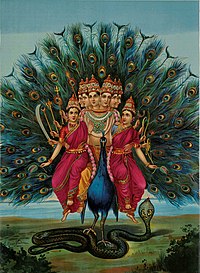Kataragama deviyo

Kataragama deviyo (also called: Skanda Kumara, Kartikeya,
Today Ruhunu Maha Kataragama devalaya has become a temple which attracts and unites people of different
Legends and beliefs

Kataragama deviyo is native and long-celebrated in Sri Lankan lore and legend. Since ancient times an inseparable connection between Kataragama deviyo and his domain has existed. At some point in the history it is believed that he resided on the top of mountain Wedahitikanda, just outside the Kataragama town. The temple dedicated to Kataragama deviyo in Kataragama has been a place of pilgrimage and religious sanctity for thousands of years.
According to some legends God Kataragama originally lived in the
Another belief about God Kataragama is that King Mahasen of the
It is believed that the present spiritual residence of Kataragama deviyo lies in the jungles of south eastern Sri Lanka, where he is spending his time in meditation. The area known as Kebiliththa, located in the Yala National Park is one such location where devotees visit, after practicing strict religious rituals such as vegetarianism and abstinence to get the blessings of the god.[10] However, it is believed that Kataragama deviyo visits the Kataragama temple on special occasions, such as Eslala festival days and poya days.[10] Hence a minister of God Kataragama known as Kadawara deviyo, is believed to be the present guardian of the Kataragama temple.[11][12]
Kataragama devalaya

According to legends, the Ruhunu Maha Kataragama Devalaya was built by
The building of the Kataragama temple is a simple structure with two apartments and it has not undergone any major structural alterations after its construction.
The
Esala festival
The main event that is held to pay homage to Kataragama deviyo is the annual Esala Festival held at Kataragama in July or August. The traditional rituals of the annual Kataragama Esala festival starts with traditional Kap Sitaweema ceremony that take place at an auspicious time after the conclusion of Poson Poya day. Kap situweema is the installation of a sanctified log known as kapa at the premises of the temple. Devotees after having a bath in Menik Ganga (a river flowing near to the Kataragama temple) dressed in clean white clothes, walk across to the temple bearing offerings of flowers and fruit to the god, expect to obtain blessings to begin the Esala festival.[17]

Kataragama Esala Perehera is the most spectacular event of the annual Esala festival, which is held in the nights of festive season. A procession (perehera) with traditional dancers, kawadi dancers, drummers, fire walkers, elephants and many other religious rituals, it is known as one of the most elegant historical cultural pageants in Sri Lanka.[18] The
The water-cutting ceremony that brings the festival to an official end is held in the Menik Ganga, the morning after the final procession take place on the full moon night. The final rite is the Diya Kapeema, where Kapurala (official of the temple) cut water of the river with a sword to ceremonially end the annual festival. Thereafter the devotees plunges into the shallow waters of Manik Ganga for purification, before departing to their everyday lives.[6]
See also
References
- ^ Kariyawasam, A. G. S. (1995). "The Gods & Deity Worship in Sri Lanka". WWW Virtual Library - Sri Lanka. Retrieved 26 December 2014.
- ISBN 978-0-8006-9790-7.
- ^ Piyaratne, Nelson. "God Kataragama and his supreme identity". Daily News. Archived from the original on March 10, 2013. Retrieved December 26, 2014.
- ^ "On Foot by Faith to Kataragama". The Sunday Leader.
- ^ Pinkham, Mark Amaru (July–August 2007). "The Return of the King of the World". Atlantis Rising. Retrieved 12 June 2014.
- ^ a b c d e Sadanandan, Renuka. "Divine Power of God Kataragama". Serendib. Retrieved December 29, 2014.
- ^ ISBN 978-955-0600-00-7.
- ^ a b Amarasekara, Janani (13 January 2008). "Blessed Kataragama". Sunday Observer. Archived from the original on 29 December 2014. Retrieved 29 December 2014.
- ^ S.P.B.M. Ranasinghe (25 September 2020). "Bandara Devatha". Sri Lankan gods and goddesses, Lanka Wisdom.
- ^ a b Amarasinghe, Udeshi (November 2011). "Kebiliththa: Divine Belief". Explore Sri Lanka. Retrieved 30 December 2014.
- ^ Witane, Godwin (3 March 2001). "Kataragama: Its origin, era of decline and revival". The Island. Retrieved 30 December 2014.
- ^ Sri Lankan Gods and Goddessess
- ^ a b Fernando, Lionel. "Ruhunu Kataragama Maha Devalaya". The Kataragama-Skanda website. Retrieved December 26, 2014.
- ^ Illankoon, Duvindi; Jeewandara, Shaveen. "Kataragama: Beyond the festival, a story of people and faith". Sunday Times. Retrieved 30 December 2014.
- ^ "Teyvani Amman Temple festivities at Kataragama". The Ceylon Daily News. Retrieved December 26, 2014.
- ^ "Kataragama". Travel Sri Lanka. Retrieved December 26, 2014.
- ^ a b "Kataragama Esala Festival". Sunday Times. Retrieved December 26, 2014.
- ^ "Kataragama Esala festival begins in Southern Sri Lanka". ColomboPage. Retrieved December 26, 2014.
- Bastin, Rohan (December 2002). The Domain of Constant Excess: Plural Worship at the Munnesvaram Temples in Sri Lanka. Berghahn Books. ISBN 1-57181-252-0.
